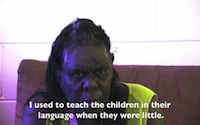The Iwaidjan Language Family
The languages of the Iwaidjan family are all spoken in the Cobourg Peninsula region of the Northern Territory, Australia. This region of Australia has an astonishing level of linguistic diversity. Representatives of a third of the approximately twenty-five high-level family groupings of Australian languages are, or were once, spoken in this small region, barely larger than Belgium.
Languages of the Region
The following family tree shows the internal relationships of languages in the Iwaidjan family.
Iwaidjan Language Family
A first idea of the degree of relatedness between members of the family can be obtained from the following short comparative lists, which include three members of the Iwaidjan family (Marrgu, Iwaidja and Ilgar) as well as two other languages of the region: Tiwi to the west, on Bathurst and Melville Islands, and Kunwinjku from the mainland to the south. Cells containing related words have been shaded to aid the comparison.
Relatedness of Iwaidjan Languages
The Iwaidjan languages, though related to other Australian languages at a remote level, diverge markedly from them in many respects, and display many unique or at least extremely unusual typological features.
Phonologically, their most remarkable feature is an exceptionally rich inventory of liquid phonemes, with at least eight and possibly nine liquid phonemes, comprising three rhotics or ‘r-like phonemes’ and five or six laterals.
In terms of grammatical typology, again the Iwaidjan languages offer many unusual characteristics. Overall, they are ‘head-marking languages’ giving a great deal of information on the verb, including agreement prefixes for subject and object, direction, and tense, but have many unfamiliar twists:
• Kinship Verbs
All the Iwaidjan languages have an elaborate set of kinship verbs alongside regular kinship expressions, so that ‘my father’ is expressed, for example by combining the transitive verb ‘be father to’ with the prefix denoting a third person subject and a first person object. Outside the Iwaidjan family, virtually all clear cases of kinship verbs are found in the languages of the Americas, and the Iwaidjan languages present an important counter-balance to our understanding of how these work.
• Mutation
Uniquely in Australia, Iwaidja has ‘initial mutation’ similar to that found in Welsh or Irish Gaelic, changing initial consonants according to such grammatical environments as number (cf a-maju ‘they are sick’ but baju ‘(s)he is sick’).
• Inflecting Prepositions
Though inflecting prepositions are not unknown in languages from elsewhere in the world (e.g. Welsh, Hungarian), in those languages prepositions always agree with their objects, whereas in the Iwaidjan languages prepositions agree with their subjects.
• Deponent Object Markers
On normal transitive verbs in these languages, there are prefixes indicating subject and object, including their gender if third person. In addition, however, there are verbs which take apparent object markers which have no relation to the verb’s object, as assessed on other grounds. For example, in the verb ma-…-wurudban ’have animal OBJ (e.g. bullock, turtle) secured on end of rope’ the ma-prefix occupies the object prefix slot, but the actual grammatical object (e.g. bullock, or turtle, either of which belongs to a different gender to that denoted by the ma-prefix) must be represented by a nominal phrase outside the verb.
The Iwaidjan languages also hold a key position for our understanding of the Australian Language Family. It is likely that they hold the key to demonstrating the historical relatedness of the (purported) isolate Tiwi to other Australian languages, once reconstruction of Iwaidjan lexicon and phonology has been achieved. The large numbers of Macassan loanwords they have received, stratified with respect to language-internal sound changes, additionally gives them special significance in understanding the linguistic prehistory of contacts with Indonesian seafarers. Further, despite their radical phonological changes, they retain a rich set of conservative verbal morphemes which will play a central role in morphological reconstruction among the non-Pama-Nyungan languages. These languages, though they cover only about one eighth of Australia’s land area, between them account for over 90% of its linguo-genetic diversity.
Current state of Iwaidjan languages
Despite the remoteness of the area, and the fact that virtually all of it is reserved Aboriginal land, most of the languages of the group are extinct or threatened with imminent extinction, and only two – Iwaidja and Maung – have speech communities large enough to ensure daily use by a full age range including children. Best current estimates suggest there are around two hundred speakers each for Iwaidja and Maung.
Senior Language Consultants
All of the remaining Iwaidjan languages have become extinct or severely endangered in the 150 years since European contact. Wurrugu is no longer spoken, though one man remembers a few words. The last speaker of Marrgu died in September 2003, though Joy Williams, in her fifties, is able to understand previously recorded data and these are being transcribed and translated as part of the project. Amurdak has at most a couple of speakers. The last full speaker of Garig/Ilgar and of Manangkarri – the same man who was the last speaker of Marrgu – died last September, though again there are younger people who understand these languages and will be helping to transcribe and translate older tapes as part of this project. The relatively better position of Iwaidja and Maung today appears to stem from the use of Iwaidja as a lingua franca among Aboriginal people working in the pearling and other early industries of the region, and in the case of Maung from its use on the Goulburn Island mission.




